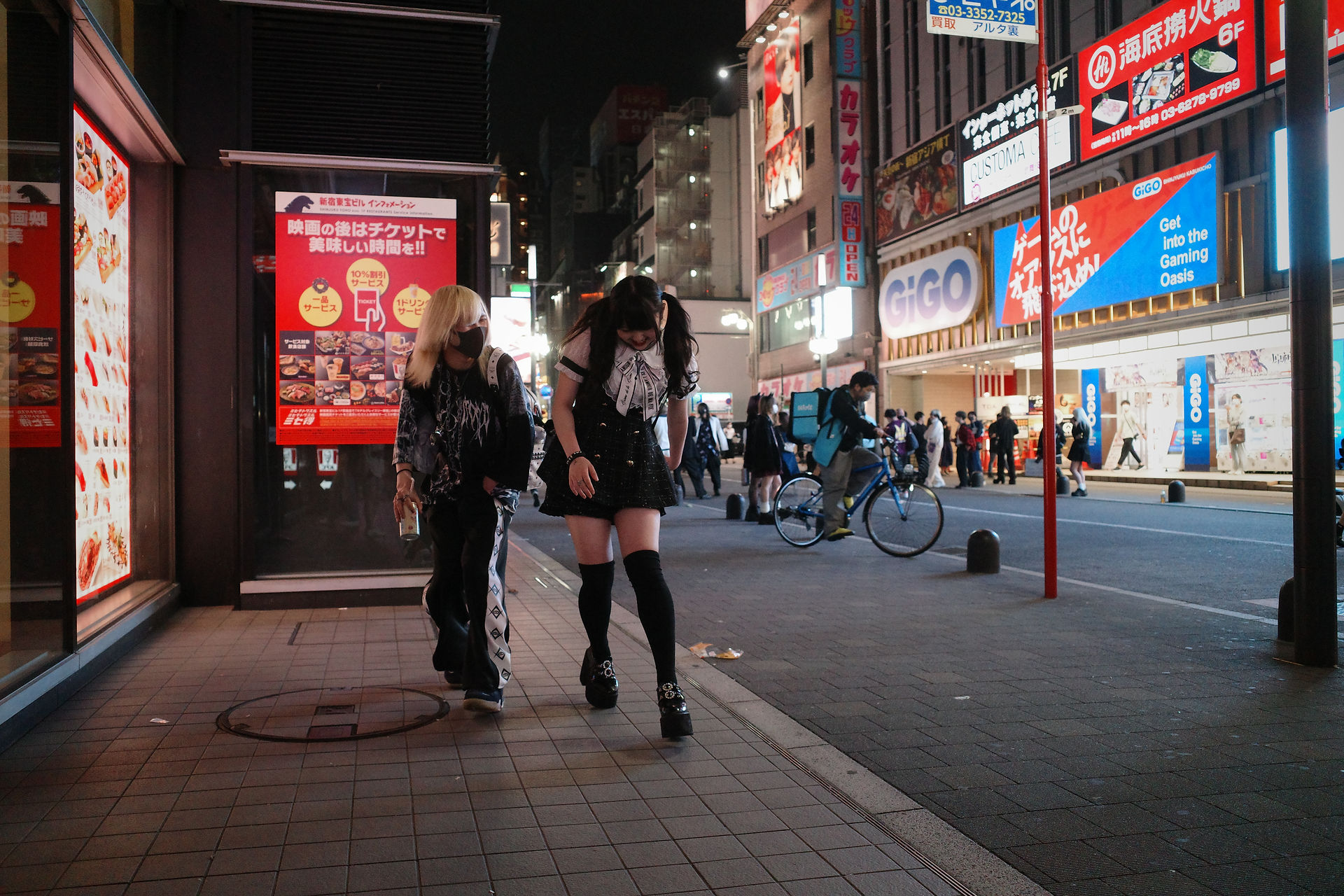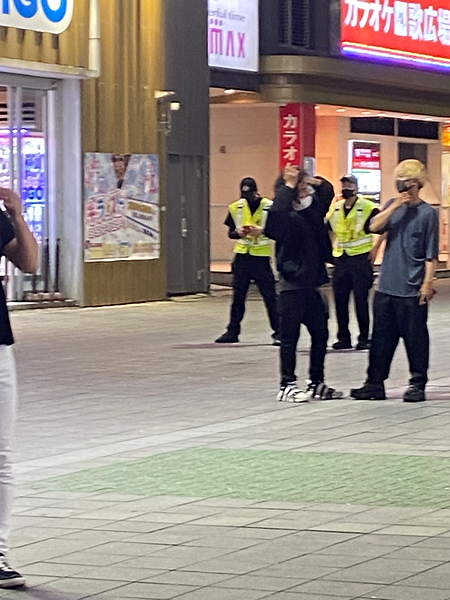
Security of Toyoko Kids
Interaction with security
by Norika
Introduction
The Toyoko hiroba is constantly populated by Toyoko kids, at all hours of the day. As an urban subgroup viewed as disruptive or trouble-causing by the rest of society, the city has placed security guards to be present, monitoring the every move of Toyoko kids. (For more information about how Toyoko kids are viewed by society, see this page). The role of these security guards is to watch and control the actions of Toyoko kids. Legally, they are unable to force Toyoko kids to do anything, however, warn Toyoko kids when certain illegal actions are taken, and step in when outbursts of violent actions occur. However, because of their constant presence and inability to make significant changes in the actions of Toyoko kids, Toyoko kids have adapted a way to interact with the security in a way that allows them to continue their lifestyle under the watch of security guards. Despite security guards being present to manage the location, a study conducted on youth in New York displayed that “most young people reported that the cumulative impact of adverse interactions with police, security guards, teachers, and store staff is that it makes them feel unwelcome in presumably “public spaces” (Fine, et al., 2003). The security guards create an unwelcome environment for Toyoko kids in the hiroba as well, as they feel obligated to act in certain ways in a public area. There are two main ways Toyoko kids have adapted their ways of interacting with security, and are discussed in the following sections:

1. Toyoko Kids Disobeying Security Guards

Photo taken June 23rd, 2022
Toyoko kids constantly being surrounded by security guards has led to them to degrade the power of security guards, and know they have no power to do anything to stop their actions. Because of this, Toyoko kids often disobey or simply run away from security when they are asked to stop a specific action such as smoking. Security guards are present in order to set a specific ambiance in the hiroba, however, Toyoko kids have taken advantage of the situation they are in, where security guards create an unwelcome environment for them to spend time in the public space (the hiroba).
Example
The use of smoking as a tool for communication has been revealed in the following section (click here). One of the Toyoko kids was seen smoking a cigarette and told to stop by the security guard. Instead of immediately stopping, the Toyoko kid simply walked away from the situation to a different location of the hiroba. There, he lit another cigarette and proceeded to smoke (refer to the photo). This displayed the attitude Toyoko kids have towards the security guards, and the way they interact with each other. In other urban situations, being told by the security to stop a specific action would result in a quick compliance by the individual. The interaction and the relationship Toyoko kids and security have built is demonstrated in this attitude.
2. Having a Blasé Attitude
According to David Karp, individuals in urban areas are constantly exposed to constant stimuli. These stimuli come from other strangers passing the streets, signboards with bright lights, and constant movement form vehicles, and people. In his own words, Karp states “the incessant bombardment of incompatible stimuli upon individuals ultimately exhausted their mental energies and renders them incapable of response to every new occurrence” (Karp et al., 2015). In order to avoid constantly interacting with all of such stimuli, individuals have a blase attitude towards specific interactions they do not wish to interact with. In an urban setting, the interaction with each interaction would result in an individual being exhausted and tired from the constant interactions that would be caused by the abundance of movement and occurrences.
How does this apply to Kabukicho?
To put this into the context of Kabukicho, when walking down Ichiban Dori, catch constantly approach individuals, asking if they are interested in drinking at their izakaya, or are looking for a place to drink. Constantly being approached, especially when not looking for an izakaya, individuals will walk past the catch as if they never interacted. In other settings, this action of ignoring may be considered rude, however, the constant approaches along all streets of Kabukicho have normalized this blase attitude.
Example
In the hiroba, Toyoko kids and security are in constant interaction with each other. Because of this constant interaction (constant stimuli), Toyoko kids have turned to having a blase attitude towards the security guards, ignoring them and acting as if the security guards are not present. Additionally, security guards have a blase attitude towards toyoko kids, and often ignore or turn a blind eye towards underage drinking, or other illegal activities. They were even seen on their phones, as if they were uninterested in the situation. The signs that prohibit individuals from collecting in the hiroba are ignored, and underaged drinking and smoking are also a problem. However, security guards ignore these activities, and act as if they are not happening. This comes from not wanting to engage every time Toyoko kids drink underage, or collect in the hiroba as it is a constant occurrence that has been ignored to the point of becoming normalized.
Video taken July 2nd, 2022
However, this attitude changes when they are asked by police, as Toyoko kids are aware of the difference in power that these security guards hold. When police arrive on the scene, Toyoko kids immediately have a different attitude, and act much more cautiously. They warn each other by saying “警察来たよ!” (translation: “the police are here”), and stand in groups as if they are not doing anything. Police are not always present in the hiroba, and have more authority to do more than the security guards who are constantly present. Because of this, there is a difference in interaction between Toyoko kids and security guards and police.

Image taken June 23rd, 2022
3. Maintaining Civil Inattention
Practicing civil inattention in public places means “that one gives to another enough visual notice to demonstrate that one appreciates that the other is present, while at the next moment withdrawing one’s attention from him so as to express that he does not constitute a target of special curiosity or design” (Goffman 1963). In urban settings where interactions are constant, individuals choose to simply acknowledge others without fully interacting with them. A very similar situation is displayed in the constant interaction between security guards and Toyoko kids. In some instances, they choose to ignore each other completely (see 2. Having a Blase Attitude). However, there are instances where they acknowledge their presence without any form of interaction.
Example
The video below demonstrates Toyoko kids practicing civil inattention towards security guards. In this specific instance, a Youtuber is interviewing Toyoko kids, and security guards are casually passing through the area, observing and watching the interview as well as the actions of the Toyoko kids. The Toyoko kids realize and notice the security guard, however, do not interact with him other than a slight glance or quick acknowledgement. In the video, it can be seen that the group of Toyoko kids sitting on the ground and railing appear as though they are talking about the security guard, looking up and glancing in his direction when his back is turned.
Conclusion and Analysis
Disobeying, having a blasé attitude, and practicing civil inattention are all ways Toyoko kids and security guards interact with each other. All of these actions stem from Toyoko kids not feeling welcome or not feeling as if they are seen as individuals. The representation in the media and simply the presence of Toyoko kids in a public space. On one hand, even though Toyoko kids have claimed the hiroba as if it is their own, it still remains a public space. However, the Toyoko kids being young adolescents changed the way they are viewed by the rest of society. From this, Toyoko kids and security only interact in a distrusting way, where both communities are skeptical of the other’s actions. This mistrust created the interactions of disobeying, having a blase attitude and practicing civil inattention as the main ways these communities interact.
Sections
Use of Language
